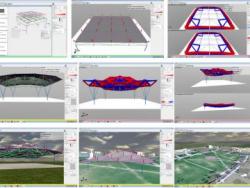e-Learning and e-Design
SAFAS is a curriculum-support application for Architecture students learning Structural Engineering.
- Explanatory Resources include multimedia on fundamentals and case studies.
- Interactive Resources include X3D client (Xj3D) coupled with web-based simulation service (SAP) and courseware management (Scholar).
All resources are annotated with Dublin Core metadata and cross linked for clarity.
 Structure and Form Analysis System (SAFAS) is an interactive 3D design tool and curriculum for architects learning structural engineering. The Structure And Form Analysis System (SAFAS) project began as a pedagogical tool for undergraduate architecture education; however, its functionality is unique and significant enough to be useful for practitioners as well. The project is a collaboration between the Architecture, Education and Computer Science departments at Virginia Tech to develop and evaluate the use of simulation tools in design education. There are both explanatory and interactive resources for the structure and form curricula:
Structure and Form Analysis System (SAFAS) is an interactive 3D design tool and curriculum for architects learning structural engineering. The Structure And Form Analysis System (SAFAS) project began as a pedagogical tool for undergraduate architecture education; however, its functionality is unique and significant enough to be useful for practitioners as well. The project is a collaboration between the Architecture, Education and Computer Science departments at Virginia Tech to develop and evaluate the use of simulation tools in design education. There are both explanatory and interactive resources for the structure and form curricula:
- Explanatory Resources (Module 1) include multimedia (extensive text, image, video) on fundamentals and case studies of space frame structures. The resource included in this sub-module covers topics such as background and historical development, various advantages and disadvantages, systems, assembly and erection, and case studies.
- Interactive Resources (Module 2) include a Java client application (built with Xj3D) coupled with web-based simulation service (SAP) and courseware management (Scholar). This component helps students to experiment with the structural modeling and preliminary design of spatial structures, as well as the post-processing of the structural analysis results in the form of animated structural models, glyphs and color-coded element stresses.
In the development of this project, we are fostering the education of: (a) students by improving their ability to integrate structural systems into architectural designs, and (b) instructors by improving their technical knowledge. With the ability to view a variety of design possibilities immediately, users can work through many different types of design problems and solutions. Having the ability to observe and compare the similarities and differences of the deformations and stresses of the structural members across diverse design conditions improves the user’s understanding of relationship between structure and form and his/her ability to transfer these skills to other design problems in the future. Funded in part by the National Science Foundation under grant No. TUES- 0817106.



